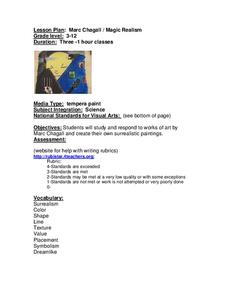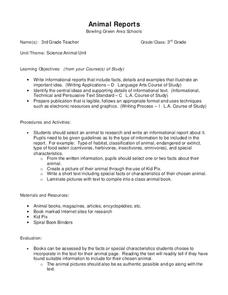Curated OER
Where in the World?
Sixth graders research online various types of poetry. In this poetry analysis activity, 6th graders research different types of poetry online, their characteristics, and poets. Students create a class atlas that incorporates the seven...
Curated OER
Language Arts: Creating Original Fiction
Fourth graders create fictional stories and demonstrate the use of various writing techniques. After selecting their main ideas, they find appropriate graphics to use as illustrations. In groups, 4th graders apply Hyperstudio in...
Curated OER
The Artist As Storyteller
Students practice the art of storytelling by examining scroll writing techniques of Asia and applying them to a monthly story of their own classroom. This lesson is in two parts (Part II continues throughout the school year).
Curated OER
Keyboarding - Scattergories for Typing
Students engage in a game aimed at increasing keyboarding skills.
Dick Blick Art Materials
Ball Point Engravings
Turn simple pencil sketches into colorful engravings. After first creating hand-drawn pictures, young artists then trace over them will ball point pens, etching the images into cold press illustration boards, before rubbing crayons over...
Norfork School District
Habits of Mind
Why do artists create? To solve a problem, of course. Young artists work individually and then in groups to create observational, imaginative, and narrative drawings in response to an assignment that requires them to employ all 16 Habits...
Duluth-Superior Area Educational Television Corporation
Marc Chagall / Magic Realism
Surrealistic painters like Marc Chagall and Wendy Rouse show viewers an expansive world in a small area. Young artists have a opportunity to create their own surrealistic paintings in response to a study of works by Chagall and Rouse.
Missouri Department of Elementary
What Are Bullying and Harassment? Part 2
After reviewing notes from the previous lessons, small groups obtain a scenario card that describes a situation in which bullying is happening. Peers discuss the event and brainstorm two solutions using the STAR method then present their...
Virginia Department of Education
Researching Information on the Internet
Practice Internet research skills. Each class member will need Internet access in order to follow along as you model how to search using key words and to do their own research on African and Asian elephants. Their notes will go into a...
Curated OER
A Voyage of Endurance
Students apply the three different types of journal writing by composing one of each type on the subject of Shackleton's expedition to Antarctica. They also
write a dialectical journal summarizing the facts of the expedition and...
Curated OER
Animal Reports
Third graders choose an animal to research and write a report about. They determine the animals' habitat, animal classification, whether it is endangered or extinct, and the type of food it eats. Also, they add any special...
Curated OER
Identifying Figurative Language #1
In this identifying types of figurative language instructional activity, students read sentences and phrases, determine if they are similes, metaphors, hyperboles, personifications, or a combination, identify the type/s and write an...
Curated OER
Defending Great Literature
Students defend Mark Twain and the study of The Adventures of Huckleberry Finn using persuasive techniques, appropriate word choice, and correct letter format, in response to a fictional letter by an upset parent.
Curated OER
Heritage: Dwellings of the 5 Major Native American Tribes of Utah
Young scholars discuss and examine various types of dwellings of Native American Tribes of Utah, and create dioramas showing at least one type of Native American dwelling.
Curated OER
Mission Possible
Students, in teams, solve a crime using forensic lab techniques. They apply lab techniques to a real life situation using a crime scenario that takes place on campus. Sample activities include Blood, Fiber, and Hair Lab.
Curated OER
A Hard Sell on Stem Cells?
Learners examine their prior knowledge of cell regeneration and therapeutic use of stem cells. After reading an article, they discover new techniques for deriving embryonic stem cells. In groups, they research on the different types of...
Curated OER
Classroom Environment Review and Test
Students play a Jeopardy type review game regarding the physical classroom set up for preschool. They review the positive guidance techniques learned in prior lessons such as redirection and time outs. Following the review, students...
Curated OER
Let's Go Shopping: Estimation At The Mall
Students estimate the total cost of a shopping trip. In this estimation lesson, students use three different techniques to estimate how much a shopping trip will cost.
Curated OER
Making a Non-Fiction Big Book
Writing a non-fiction big book can help students learn about research techniques, note taking, and other skills.
Curated OER
Design a Parachute
Students engage in a discussion about what a parachute is and how it works. They create a parachute using different materials that they think will work best. The students test their designs, which will be followed by a class discussion...
Curated OER
Similes, Metaphors, and Symbols
Here is an outline of a lesson in which learners examine the use of similes, metaphors, and symbols in poetry. They define similes, metaphors, and symbols, complete a handout, and create a poem using types of figurative language.
Curated OER
Personal Development - Setting Goals to Achieve Objectives
Students explore reasons for setting goals and techniques to achieve them. They discover the importance of setting goals, both short-range and long-range. Students assess their own situation and write specific goals to meet their...
Curated OER
What's in the Water?
Students make a water sampler and use proper techniques to collect water.They write a essay explaining the inter-relationship of factors such as temperature, pH, dissolved oxygen, nitrates, and phosphates in a lake that might cause a...
Curated OER
What a Character!
Students look at the role of characters in a story. For this character lesson, students discuss how different types of characters change the plot of the story. They see how storytellers use their body, face, and voice to tell stories.

























